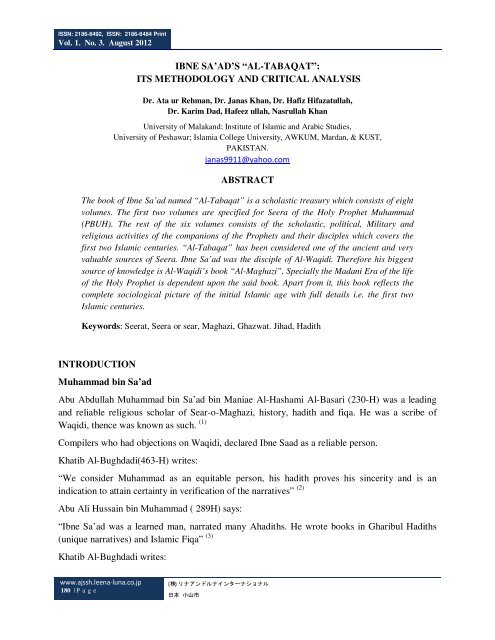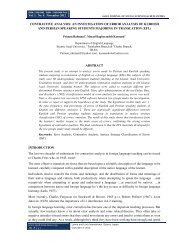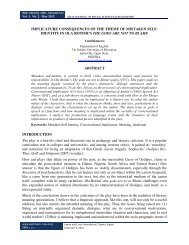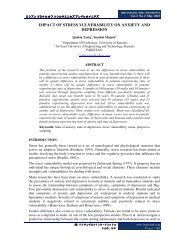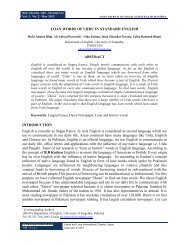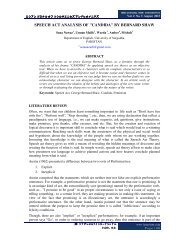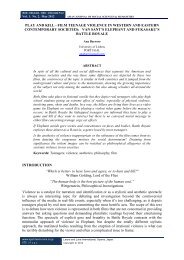Full Paper - Asian Journal of Social Sciences and Humanities (AJSSH)
Full Paper - Asian Journal of Social Sciences and Humanities (AJSSH)
Full Paper - Asian Journal of Social Sciences and Humanities (AJSSH)
Create successful ePaper yourself
Turn your PDF publications into a flip-book with our unique Google optimized e-Paper software.
ISSN: 2186-8492, ISSN: 2186-8484 Print<br />
Vol. 1. No. 3. August 2012<br />
IBNE SA’AD’S “AL-TABAQAT”:<br />
ITS METHODOLOGY AND CRITICAL ANALYSIS<br />
Dr. Ata ur Rehman, Dr. Janas Khan, Dr. Hafiz Hifazatullah,<br />
Dr. Karim Dad, Hafeez ullah, Nasrullah Khan<br />
University <strong>of</strong> Malak<strong>and</strong>; Institute <strong>of</strong> Islamic <strong>and</strong> Arabic Studies,<br />
University <strong>of</strong> Peshawar; Islamia College University, AWKUM, Mardan, & KUST,<br />
PAKISTAN.<br />
janas9911@yahoo.com<br />
ABSTRACT<br />
The book <strong>of</strong> Ibne Sa’ad named “Al-Tabaqat” is a scholastic treasury which consists <strong>of</strong> eight<br />
volumes. The first two volumes are specified for Seera <strong>of</strong> the Holy Prophet Muhammad<br />
(PBUH). The rest <strong>of</strong> the six volumes consists <strong>of</strong> the scholastic, political, Military <strong>and</strong><br />
religious activities <strong>of</strong> the companions <strong>of</strong> the Prophets <strong>and</strong> their disciples which covers the<br />
first two Islamic centuries. “Al-Tabaqat” has been considered one <strong>of</strong> the ancient <strong>and</strong> very<br />
valuable sources <strong>of</strong> Seera. Ibne Sa’ad was the disciple <strong>of</strong> Al-Waqidi. Therefore his biggest<br />
source <strong>of</strong> knowledge is Al-Waqidi’s book “Al-Maghazi”, Specially the Madani Era <strong>of</strong> the life<br />
<strong>of</strong> the Holy Prophet is dependent upon the said book. Apart from it, this book reflects the<br />
complete sociological picture <strong>of</strong> the initial Islamic age with full details i.e. the first two<br />
Islamic centuries.<br />
Keywords: Seerat, Seera or sear, Maghazi, Ghazwat. Jihad, Hadith<br />
INTRODUCTION<br />
Muhammad bin Sa’ad<br />
Abu Abdullah Muhammad bin Sa’ad bin Maniae Al-Hashami Al-Basari (230-H) was a leading<br />
<strong>and</strong> reliable religious scholar <strong>of</strong> Sear-o-Maghazi, history, hadith <strong>and</strong> fiqa. He was a scribe <strong>of</strong><br />
Waqidi, thence was known as such. (1)<br />
Compilers who had objections on Waqidi, declared Ibne Saad as a reliable person.<br />
Khatib Al-Bughdadi(463-H) writes:<br />
“We consider Muhammad as an equitable person, his hadith proves his sincerity <strong>and</strong> is an<br />
indication to attain certainty in verification <strong>of</strong> the narratives” (2)<br />
Abu Ali Hussain bin Muhammad ( 289H) says:<br />
“Ibne Sa’ad was a learned man, narrated many Ahadiths. He wrote books in Gharibul Hadiths<br />
(unique narratives) <strong>and</strong> Islamic Fiqa” (3)<br />
Khatib Al-Bughdadi writes:<br />
www.ajssh.leena-luna.co.jp<br />
180 | P a g e<br />
( 株 ) リナアンドルナインターナショナル<br />
日 本 小 山 市
ASIAN JOURNAL OF SOCIAL SCIENCES & HUMANITIES<br />
ISSN: 2186-8492, ISSN: 2186-8484 Print<br />
Vol. 1. No. 3. August 2012<br />
“He is the one amongst the learned, pursuit <strong>and</strong> with best character. He had<br />
classified the period <strong>of</strong> Sahaba (Companions <strong>of</strong> Prophet) <strong>and</strong> Tabe’en (Companions<br />
<strong>of</strong> Sahaba) till his own age, arranged nicely <strong>and</strong> preferably in a big volume” (4)<br />
Tabqat-ul-kubra, his book which consists <strong>of</strong> eight volumes is in the real sense a literacy treasury,<br />
the first two volumes are specified for Seerat-e-Nabvi (Prophet’s life) <strong>and</strong> the history <strong>of</strong> early<br />
prophets. They are linked with Prophet (Muhammad PBUH) as ancestors. Thereafter the<br />
Prophet’s childhood, the symptoms <strong>of</strong> prophecy, prevailing before <strong>and</strong> after his inspiration,<br />
including the preliminary conditions that existed at the time <strong>of</strong> his invitation to the people to<br />
believe in Islam, till the hijra to Madina, have been discussed.<br />
In the period <strong>of</strong> Madina, after mentioning his comm<strong>and</strong>s, the visit <strong>of</strong> Arab delegates to Madina,<br />
the lifestyle, ghazawat <strong>and</strong> his sad demise with funeral rites, patrimony, etc. Ibne Sa’ad also<br />
arranged the funeral notes in his book. Moreover the extensive information, Ibne Saad had<br />
collected regarding Shamail (qualities) Dalail (pro<strong>of</strong>) <strong>and</strong> Fazail (merits) are quoted as specimen<br />
in the literature <strong>of</strong> the concerned fields.<br />
The remaining volumes <strong>of</strong> the book Tabqat-ul-Kubra, which are not only helpful in perfection <strong>of</strong><br />
Seerat <strong>of</strong> the Holy Prophet (PBUH) but also contains the merits <strong>and</strong> qualities <strong>of</strong> Muslim Jurists<br />
<strong>of</strong> Madina, Sahaba <strong>and</strong> Tabeen, <strong>and</strong> the incidents <strong>and</strong> the oral agreements <strong>of</strong> the prophet. Ibne<br />
Saad, though had used the narratives <strong>of</strong> Musa bin Uqba, Abu Ma’asher, Ibne Ishaque, Ibne<br />
Hisham, Kalbi <strong>and</strong> Abdullah bin Muhammad, yet was the scribe <strong>of</strong> Waqidi, thus his book “Al-<br />
Maghazi” was the main source <strong>of</strong> his (saad’s) information <strong>and</strong> more particularly in the<br />
description <strong>of</strong> occurrences <strong>of</strong> Madina, he remained Waqidi’s dependent. (5)<br />
Ibne Sa’ad in his description never forgets to inform us about the minute <strong>and</strong> particular parts <strong>of</strong><br />
an event, as he informs us that whose funeral prayer was led by whom <strong>and</strong> who took him down<br />
in the grave showing the date <strong>and</strong> year <strong>of</strong> the event. Similarly he gave even the list <strong>of</strong> those<br />
Muslims who had hiddenly <strong>of</strong>fered funeral prayer at Dar-ul-Arqam <strong>and</strong> likewise informs his<br />
readers about the outcome <strong>of</strong> the brotherhood between Ansars <strong>and</strong> the refugees <strong>of</strong> Macca, telling<br />
them about the full detail <strong>of</strong> help given by Ansars to them (6)<br />
Further, Ibne Sa’ad approaches to Tabqat (order in ranking) are like an innovators <strong>and</strong> before<br />
narrating any narrative, he prefers to discuss the certification, to verify its correctness. However<br />
the fact, that Maqtoo (cut <strong>of</strong>f) hadith <strong>and</strong> Mursal (dropping ones teacher) both kinds <strong>of</strong> narratives<br />
are found in Tabqat, nevertheless be disregarded, as it is no way difficult for the well informed,<br />
to test <strong>and</strong> verify these, in the light <strong>of</strong> their certificates. (7)<br />
Ibne Sa’ad narrates the different narratives <strong>of</strong> Seerat-o-Maghazi in an arranged style for instance,<br />
pointing out to Hashim Kalbee’s writing, that the one who took part in the battle <strong>of</strong> Badar was<br />
Saib bin Mazuan <strong>and</strong> was not the one known as Saib bin Usman bin Mazuon.<br />
Ibne Saad reviewing this not only blames Kalbi for the mistakes but he also clarifies the error.<br />
According to him, all the writers know this fact that ibne Usman bin Mazuon had taken part in<br />
Leena <strong>and</strong> Luna International, Oyama, Japan.<br />
Copyright © 2012<br />
www. leena-luna.co.jp<br />
P a g e | 181
ISSN: 2186-8492, ISSN: 2186-8484 Print<br />
Vol. 1. No. 3. August 2012<br />
all the battels including the battle <strong>of</strong> Badar <strong>and</strong> Uhad. From this incident, it shows Ibne Sa’ad’s<br />
keen observation <strong>and</strong> criticism on others. (8)<br />
The use <strong>of</strong> verses by Ibne Sa’ad in his book Tabqat is nominal, however he had used variously<br />
some <strong>of</strong> verses in Khutbat (addresses) (9) <strong>and</strong> he had also cited Quranic verses as evidence in<br />
support <strong>of</strong> some <strong>of</strong> the events. In short, he had, in his book Tabqat, besides discussing the Seerat<br />
Nabvi, also collected information relating to social intercourse <strong>of</strong> primal period <strong>of</strong> the Muslims<br />
so magnificently, which scattered parts if gathered will be sufficient for framing a complete<br />
picture, surrounding almost the three long centuries <strong>of</strong> the age. (10)<br />
CONCLUSION<br />
Ibne Sa’ad may be the first Author who collected “The Signs <strong>of</strong> the Prophethood”. This proved<br />
to be a mile stone for the future writers on “Pro<strong>of</strong>s <strong>of</strong> the Prophethood”.<br />
One part <strong>of</strong> the said book consists <strong>of</strong> “The Manners” <strong>of</strong> the Holy Prophet (PBUH). This also<br />
proved to be the first step on this topic for the coming authors.<br />
This book is an exemplary publication about the life histories <strong>of</strong> the renowned personalities <strong>and</strong><br />
is also a unique <strong>and</strong> valuable source <strong>of</strong> Seera.<br />
This book reflects a complete picture <strong>of</strong> the scholastic, political <strong>and</strong> religious activities <strong>of</strong> the<br />
companions <strong>of</strong> the Holy Prophet <strong>and</strong> their disciples which covers the first two Islamic centuries.<br />
Ibne Sa’ad merges different Assaneed (chains <strong>of</strong> narrators) about a historical event rather than<br />
narrating an event in many ways. In this way he facilitates his readers from the repetition about a<br />
single event.<br />
REFERENCES<br />
1. Alfahris, Ibne Nadeem Ravi Offist Printing Tehran, Iran 1973 Page 111 Tarikh Baghdad<br />
321/5<br />
2. Tehzib-ul-Tahzib 119/5. Tarikh-e-Baghdad 321/5<br />
3. Ibid,<br />
4. Ibid,<br />
5. Ancients book on Seerat Nabvi <strong>and</strong> their compilers, Urdu translation 784/1<br />
6. Al-Tabaqat Al-Kubra 114, 115/1<br />
7. Kutab Tabqat, Tarikh <strong>and</strong> Aasma-ur-Rijal main Sirat ka Manhaj, Dr. Suhail Hassan,<br />
Shashmahi Al-Seera Al-A’alami, Karachi, May 2001, Page 183<br />
8. Al-Tabaqat Al-Kubra 402/3<br />
9. Ibid, 165, 166/1<br />
www.ajssh.leena-luna.co.jp<br />
182 | P a g e<br />
( 株 ) リナアンドルナインターナショナル<br />
日 本 小 山 市
ASIAN JOURNAL OF SOCIAL SCIENCES & HUMANITIES<br />
ISSN: 2186-8492, ISSN: 2186-8484 Print<br />
Vol. 1. No. 3. August 2012<br />
10. Tabqat Ibne Sa’ad, Seerat Nabi Ka Qadim makhiz, Dr. Nisar Ahmad Farooqee, Risala<br />
Naqoosh Rasul number Shumara 130, December 1982. Page 555<br />
BIBLIOGRAPHY<br />
Al-Fahris, Ibne Nadeem, Ravi Offist Printing Tehran, Iran 1973.<br />
Tarikh Baghdad, Khateeb Baghdadi, Hafiz Abu Bakar Ahmad bin Ali, Maktaba Al-Sa’ada,<br />
Egypt, 1349H.<br />
Tahzib-ul-Tahzib, Ibne Hajar, Ahmad bin Ali Al-Asqalani, Dar Ahya Al-Turas Al-Arabi, Beirut,<br />
3 rd Edition, 1993.<br />
Seerat-e-Nabvi, (ancients books), Jozeph Horovitz, Urdu Translation, Dr. Nisar Ahmad Faroque,<br />
Bi-Annual Urdu journal “Nuqoosh” Rasul Number, No130, Idara-e-Farogh-e-Urdu, Lahore,<br />
December, 1982.<br />
Al-Tabqat Al-kubra, Ibne Sa’ad, Abu Abdullah Muhammad Bin Sa’ad Al-Basari, Dar-ul-Fikar,<br />
Beirut, 1 st Edition, 1994.<br />
Kutab Tabqat, Tareekh aur Aasma-ur-Rijal main Seerat ka Manhaj, Dr. Suhail Hassan, Bi-<br />
Annual Urdu journal “Al-Seera Al-A’alami”, Karachi, Edition, May 2001.<br />
Tabqat-e-Ibne Sa’ad, Seerat Nabi Ka Qadim makhiz, Dr. Nisar Ahmad Farooqee, Urdu <strong>Journal</strong><br />
“Naqoosh”, Rasul number, Edition No. 130, December 1982.<br />
Leena <strong>and</strong> Luna International, Oyama, Japan.<br />
Copyright © 2012<br />
www. leena-luna.co.jp<br />
P a g e | 183


